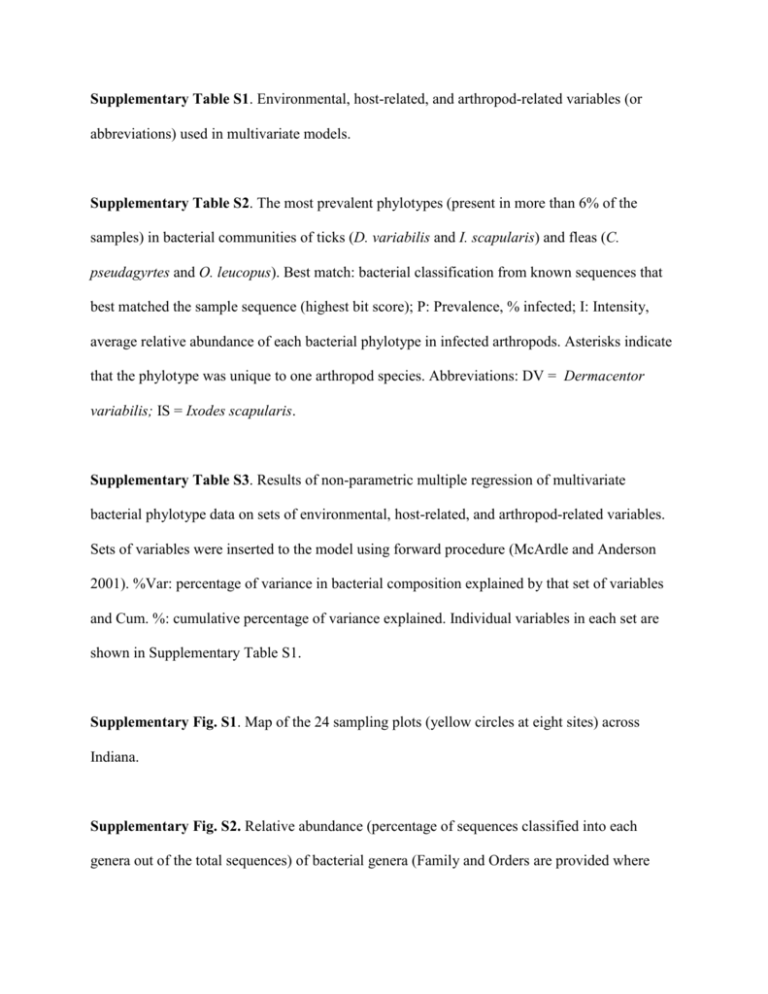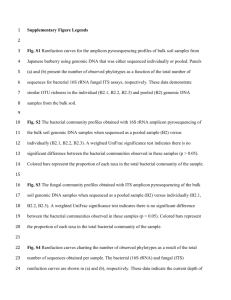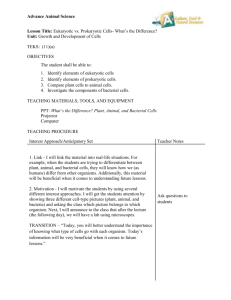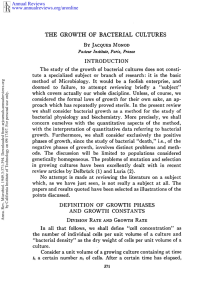Supplementary Information (doc 72K)
advertisement

Supplementary Table S1. Environmental, host-related, and arthropod-related variables (or abbreviations) used in multivariate models. Supplementary Table S2. The most prevalent phylotypes (present in more than 6% of the samples) in bacterial communities of ticks (D. variabilis and I. scapularis) and fleas (C. pseudagyrtes and O. leucopus). Best match: bacterial classification from known sequences that best matched the sample sequence (highest bit score); P: Prevalence, % infected; I: Intensity, average relative abundance of each bacterial phylotype in infected arthropods. Asterisks indicate that the phylotype was unique to one arthropod species. Abbreviations: DV = Dermacentor variabilis; IS = Ixodes scapularis. Supplementary Table S3. Results of non-parametric multiple regression of multivariate bacterial phylotype data on sets of environmental, host-related, and arthropod-related variables. Sets of variables were inserted to the model using forward procedure (McArdle and Anderson 2001). %Var: percentage of variance in bacterial composition explained by that set of variables and Cum. %: cumulative percentage of variance explained. Individual variables in each set are shown in Supplementary Table S1. Supplementary Fig. S1. Map of the 24 sampling plots (yellow circles at eight sites) across Indiana. Supplementary Fig. S2. Relative abundance (percentage of sequences classified into each genera out of the total sequences) of bacterial genera (Family and Orders are provided where phylotypes were not classified to lower taxonomic levels; UG = Unclassified Genus) in Dermacentor variabilis (N = 91), Ixodes scapularis (N = 41), Ctenophthalmus pseudagyrtes (N = 23), and Orchopeas leucopus (N = 43) based on the 103 most common phylotypes that were described by 454 sequencing and bioinformatics analyses. The most abundant sequences are given for each species; “others” indicates all remaining sequences. Taxonomic groups identified in previous studies of the microbiota of ticks, fleas, or both are indicated by one, two, or three asterisks, respectively (Andreotti et al 2011, Clay and Fuqua 2011, Jones et al 2008, Jones et al 2010, Martin and Schmidtmann 1998, Moreno et al 2006, Murrell et al 2003, Rudolf et al 2009, van Overbeek et al 2008, Yuan 2010). Supplementary References: Andreotti R, de Leon AAP, Dowd SE, Guerrero FD, Bendele KG, Scoles GA (2011). Assessment of bacterial diversity in the cattle tick Rhipicephalus (Boophilus) microplus through tag-encoded pyrosequencing. BMC Microbiol 11 article number: 6, DOI: 10.1186/1471-21801111-1186. Clay K, Fuqua C (2011). The tick microbiome: diversity, distribution and influence of the internal microbial community for a blood-feeding disease vector. Critical Needs and Gaps in Understanding Prevention, Amelioration, and Resolution of Lyme and Other Tick-Borne Diseases: The Short-Term and Long-Term Outcomes - Workshop Report. Institue of Medicine of the National Academies. Jones RT, McCormick KF, Martin AP (2008). Bacterial communities of Bartonella-positive fleas: diversity and community assembly patterns. Appl Environ Microbiol 74: 1667-1670. Jones RT, Knight R, Martin AP (2010). Bacterial communities of disease vectors sampled across time, space, and species. ISME J 4: 223-231. Martin PAW, Schmidtmann ET (1998). Isolation of aerobic microbes from Ixodes scapularis (Acari : Ixodidae), the vector of Lyme disease in the eastern United States. J Econ Entomol 91: 864-868. McArdle BH, Anderson MJ (2001). Fitting multivariate models to community data: a comment on distance-based redundancy analysis. Ecology 82: 290-297. Moreno CX, Moy F, Daniels TJ, Godfrey HP, Cabello FC (2006). Molecular analysis of microbial communities identified in different developmental stages of Ixodes scapularis ticks from Westchester and Dutchess Counties, New York. Environ Microbiol 8: 761-772. Murrell A, Dobson SJ, Yang XY, Lacey E, Barker SC (2003). A survey of bacterial diversity in ticks, lice and fleas from Australia. Parasitol Res 89: 326-334. Rudolf I, Mendel J, Sikutova S, Svec P, Masarikova J, Novakova D et al (2009). 16S rRNA gene-based identification of cultured bacterial flora from host-seeking Ixodes ricinus, Dermacentor reticulatus and Haemaphysalis concinna ticks, vectors of vertebrate pathogens. Folia Microbiol 54: 419-428. van Overbeek L, Gassner F, van der Plas CL, Kastelein P, Rocha UND, Takken W (2008). Diversity of Ixodes ricinus tick-associated bacterial communities from different forests. FEMS Microbiol Ecol 66: 72-84. Yuan DT (2010). A Metagenomic Study of the Tick Midgut. MS thesis, University of Texas, Houston.











